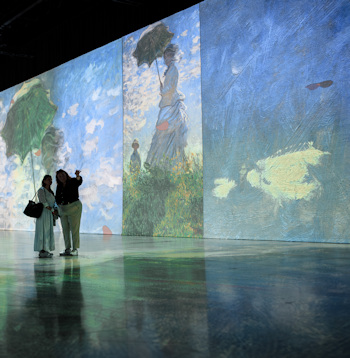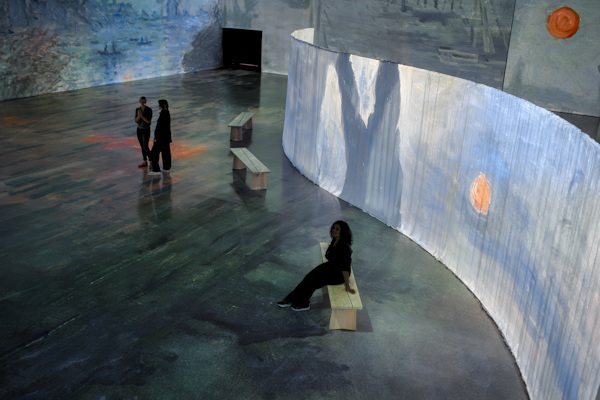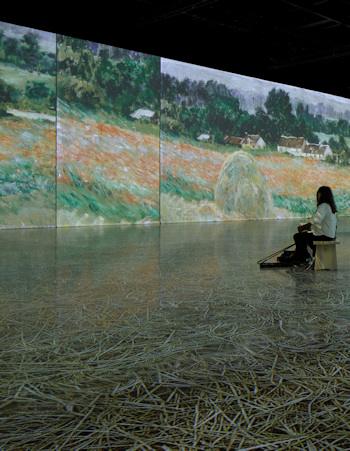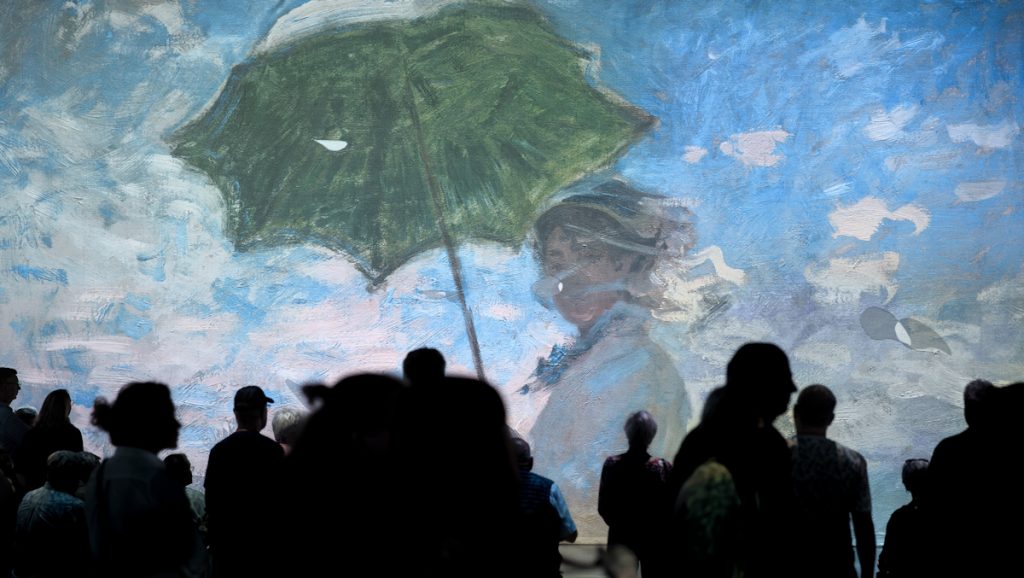
Tacoma Arts Live is currently playing host to “Imagine Monet,” an immersive art exhibit featuring giant projections of more than 200 of the paintings of the foremost of the French Impressionist painters, Claude Monet (1840-1926). The show is running at the Tacoma Armory, which Tacoma Arts Live uses as its headquarters. The Armory hosted the “Imagine Van Gogh” exhibit back in 2022.
“Imagine Monet” has been moving around the globe of late, having appeared in such locations as Stockholm, London and Quebec. The show’s producers, Annabelle Mauger and Julien Baron make the claim that their Image Totale© technology is an entirely new innovation. But the production of immersive experiences is no doubt as old as our species. Ancient religious rites, the spectacular violence of the Roman Colosseum, the development of theater, the rise of opera, the invention of cinema and the growth of virtual reality all exhibit the human desire to enter into spaces in which all of the senses are engaged, emotions are aroused and spirituality is invoked.
At “Imagine Monet”, you find yourself standing in a space surrounded by a panoply of color. The work of the iconic French impressionist is blasted onto the walls all around; on the floor even. The viewers themselves are covered in the projected colors and brush strokes of Claude Monet. Everyone in the room is transformed into a living, breathing Monet painting. And just like that, you have been immersed — baptized in the paintings of Monet, one of the high priests of art. He has reached out from the great beyond and dappled your body in blobs and squiggles of color. You are a favored child, dressed in a coat of Monet’s many colors.

This was one of this reviewer’s impressions of “Imagine Monet”, during a recent afternoon visit to the Tacoma Armory.
Such immersive art shows offer a new way to experience art — especially well-known art — art known from books, documentaries, merchandise, postcards, posters and the like. Large-scale projections of that art set to music and enhanced with digital effects allow a viewer to plunge in and renew their appreciation for iconic, perhaps over-exposed artists. This new way of engaging with the art is refreshing.
Painters themselves have often sought to envelop their viewers in their art. James McNeill Whistler’s “Peacock Room” of the 1870s is an example. The painters Marc Chagall and Mark Rothko both created chapels of their art. Monet himself donated his huge paintings of waterlilies, at the end of his life, to the French state in order that they be displayed in the round in the Musee de l’Orangerie to create an immersive experience.

Visitors to “Imagine Monet” range freely within the space. One can sit on the cluster of benches in the center, and seating pads are available for those who might want to sit on the floor. The whole affair is family friendly. Kids seem to enjoy moving all over in the cascade of color. The paintings are shown on a continual loop that takes approximately a half hour to cycle through. It starts with Monet’s 1872 painting “Impression, Sunrise” (the painting which gave the impressionist movement its name) and ends with the water lilies. In between, guests are carried away by the work of Monet on an artistic odyssey.
The paintings are clustered by theme (seaside scenes, people in gardens, people in crowded urban settings, or the new industrial landscape). There is a tour of the four seasons as one goes from paintings of snowy nature scenes to the airy light of spring, the fullness of summer and the rusty colors of autumn. There are flights through Monet’s greatest series of paintings, in which he painted the same scene or object in a variety of atmospheric effects: the seaside rock formations at E’tretat on the Normandy coast, the facade of Rouen Cathedral, the London Parliament Building and, a favorite, the muffin-like haystacks.
A musical score accompanies the flow of the visual content. The paintings flow into one another or dissolve. Often digital effects like snowflakes function as a palate cleanser between parts of the show. Some of the projections onto the floor of space are the most spectacular, as when a foamy sea surface washes over the floor, momentarily disorienting as the viewers are treated to a sequence of Monet’s paintings of boats, ships and the sea.
Extreme closeups reveal how loosely and swiftly Monet worked in some of his passages. There are sections of some of the paintings that are every bit as gestural as anything by Jackson Pollock, and yet, when the lens pulls back, the whole thing resolves itself into a delightful scene. The high-resolution nature of the projections can also show just how thick Monet could slather on the oil paint. All the while the paintings drift and flow into one another, merge into one another, fade, dissolve. … Yet there is plenty of time for the eye to luxuriate on everything.

“Imagine Monet” also includes a “discovery room” in which the main contours of Monet’s life and career are presented. Beyond the main exhibition space is a mockup of a French village where there are materials for visitors, especially children, to make their own Monet-inspired artwork.
Visitors to “Imagine Monet” are sure to come away with a new appreciation for the prolific impressionist master — more insightful as to his use of texture, his deftness of hand and his range as an artist. All of this can be useful in future engagements with Monet specifically and other artists more generally. A ticket to the show also gets you the memory of a moment in which you became a being covered in the colors of the great impressionist or the splendor of an afternoon spent submerged in a swimming pool of images.
What we don’t want to do is lose the desire to engage with paintings themselves, magical pictures done by individuals in their private little spaces using the most primal of materials: pigment and binder applied to a surface. Don’t let the big, dazzling traveling circus art displays detract from engagement with paintings in the flesh wherever you can find them.
Back in the 1960s, the French Situationist theorist Guy Debord, the father of psychogeography, put forth the idea that Western Civilization is ever trending toward becoming nothing but spectacle. Nationwide, art museums are becoming more involved in producing their own interactive art-related events. And traveling immersive shows like “Imagine Monet” seem to be gaining traction.

Immersion in the group experience and the spectacle may be fun, but it should not displace the equally powerful impulse to involve oneself with the real grit and muck of working with the actual materials of a painting, especially our own and those of people we know.
What:
“Imagine Monet”
When:
Extended through May 12
Where:
Tacoma Armory, 1001 S. Yakima Ave, Tacoma WA 98405
Cost:
Tickets start at $34
Learn More:
https://www.tacomaartslive.org/events/imaginemonet/

